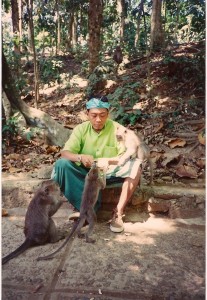 I went out to get a cup of java in Java and ended up on an infernal coffee odyssey through the Indonesian archipelago.
I went out to get a cup of java in Java and ended up on an infernal coffee odyssey through the Indonesian archipelago.
Stretching out like a Komodo Dragon some 6,400 kilometers across the Ring of Fire, from the coffee plantations and wild orangutans of Sumatra to the primary rainforests and decorative penis gourds of Irian Jaya, Indonesia is the ideal launching pad to crash land into some of the most dramatic sights in Southeast Asia. They include the ancient ruins of Buddhist Borobudur and Hindu Prambanan in Islamic Java, the multicolored volcanic lakes of Keli Mutu in Christian Flores, and the famed three-meter-long monitor lizards of Komodo that swallow entire goats whole: the prototypes, perhaps, of the Chinese dragons of legend.
Indonesia encompasses over 13,000 islands with 336 ethnic groups and a borderless rainbow babel of different languages, cultures, and traditions. In addition to coffee-colored Hindus, Christians, and Buddhists, this most densely populated café on earth (180 million) holds more Muslims than all the Middle East. Linking the islands is the lingua franca of Bahasa and an underlying songline of history: ancient animist religions are uniting threads that cross oceans, adding new meaning to the word “multicultural.” Here some Muslims drink beer and arak in addition to java; some worship Buddha, Vishnu, Krishna, and Jesus in addition to Allah; while others leave offerings to good and evil pagan spirits (tourists included). In fact, clutched in the talons of the mythical Garuda, the national airline and state crest, is the motto “Unity in Diversity.”
I departed from the Calcutta-like chaos of the capital Jakarta, a fascinating hellhole of over 9 million people, to explore the potent brews and heady smokes of Java, the volcano capital of the world. In the old Dutch section of Batavia (Kota), amidst modern skyscrapers stuck like clean syringes into a diseased dreamscape of old colonial monuments and nightmarish overcrowded kampungs, I entered the 19th-century Café Batavia on Fatahillah Square, the most atmospheric coffeehouse in Java, to keep from going troppo in the equatorial heat.
Unlike Amsterdam’s coffeehouses, which hardly ever sell coffee, the recently renovated Café Batavia offers no exotic hashish menus, nor even spicy Indonesian food, though it features colonial elegance and raffish 1930s atmosphere. Here you can quaff down the three main varieties of Indonesian coffee, in order of strength: Sumatra coffee, Bali coffee, and Java coffee—an indication of island style not bean origin. Indo coffee, like Turkish coffee, is mixed straight into the water. All wait for the psychic sludge to settle to avoid sporting roguish pencil-thin Errol Flynn mustaches of coffee grinds.
How “java” became synonymous with coffee is frothed with mystery, though not a difficult one to filter out. During almost 350 years of Dutch rule, Indonesia was the world’s largest coffee producer and the proverbial bottomless cup for the Dutch East Indies Company. Without Indonesia, the Netherlands would have gone Dutch and remained a small European country below sea level, noted only for its tulips. The term “java” was probably a slang corruption brought back by English pirates, like that of brandy for brandewijn (burnt wine).
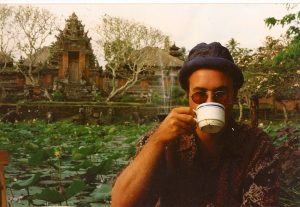 Getting from the urban epicenter to the outer limits by public transport, be it by overcrowded bus, bemo, or becak, is not so much a magical mystery tour as a year of living dangerously. But at least there is one place left in the world where you can light up, anywhere! Eventually I got to Banjar, said goodbye to the family that had been assigned seats on my lap, downed a cuppa at the station, and discovered that maybe eight hours later there just might be an onward connection. Stuck in a remote backwater like this, a Western orang bulan (moon person) always excites a crowd of staring locals. Where once upon a time children would have fled from a bearded Belanda (Hollander), screaming “Papa Beard!”—a mythical bogey man with five o’clock shadow that Indonesian parents use to frighten their kids—now they are more likely to shout out, “Hello Mister! Hello Mister!” regardless of one’s gender.
Getting from the urban epicenter to the outer limits by public transport, be it by overcrowded bus, bemo, or becak, is not so much a magical mystery tour as a year of living dangerously. But at least there is one place left in the world where you can light up, anywhere! Eventually I got to Banjar, said goodbye to the family that had been assigned seats on my lap, downed a cuppa at the station, and discovered that maybe eight hours later there just might be an onward connection. Stuck in a remote backwater like this, a Western orang bulan (moon person) always excites a crowd of staring locals. Where once upon a time children would have fled from a bearded Belanda (Hollander), screaming “Papa Beard!”—a mythical bogey man with five o’clock shadow that Indonesian parents use to frighten their kids—now they are more likely to shout out, “Hello Mister! Hello Mister!” regardless of one’s gender.
In Pangandaran, a sleepy south Javanese coastal fishing village, the entrance is guarded not by Cerberus but by a becak mafia charging a whopping wad of rupiahs to pedal you down the asphalt Lethe leading to the peninsular Pangandaran Nature Reserve. Here the Lonely Planet Café has a superb beachfront location, where friendly Muslim fishermen and their families pull in their nets, while in the distance the Call to Prayer wafts from yellow-domed mosques that shine like fried eggs in the sun. At dusk you can see the moon rising and the sun setting at the same time through a smoky cloud of fruit bats. The Lonely Planet serves standard java and Indo grub like nasi goreng (fried rice), mie goreng (fried noddles), ayam sate (chicken sate), and gado gado (salad with peanut sauce). Locals come here, though, to down fresh seafood. It’s also a good place to practice your Bahasa (originally a Malay trading language), one of the easiest tongues in the world to tame—no past or future tenses, only the laid-back present. The plural is expressed by repetition, i.e., “kopi kopi” equals two or more cups. Saya mau satu kopi? (I me one coffee?)
Pangandaran is also just far enough away from Indonesia’s most notorious offshore volcano to almost feel safe. The last time Krakatau blew its top was in 1883, with the force of several hydrogen bombs, stirring up tidal waves that killed more than 35,000, and hurling debris into the sky which caused vivid sunsets seen around the world.
In Yogyakarta, the cultural capital of Java, I brought my addiction past the Sultan’s kraton, the colorful bird market, and the manic Malioboro street vendors hawking batik shirts and sarongs, wooden and leather Wayang Kulik puppets, and demonic-looking White Monkey masks, until I finally unearthed the Café Sosro. Pulling back a curtain of Gudang Garam clove cigarette smoke, I looked around at the eclectic assortment of heavy wooden tables and chairs and the hip East-West clientele daytripping to the haunting, hypnotic strains of gamelon music. That’s good java. I even had a second cup, and looking up I noticed I was late.
Yogya (pronounced “jogja”) is close to one of the largest concentrations of Hindu/Buddhist monuments in the world, including the ancient ruins of Dieng Plateau, Prambanan, and Borobudur, which ranks up there with Cambodia’s Angkor Wat and Burma’s Pagan. On full-moon nights at Prambanan’s open-air theater, you can see the Ramayana Ballet. In the amphitheater under the stars with the floodlit Shiva temple as backdrop, the moonlit stage is filled with over 200 hundred elaborately masked and costumed dancers acting out Hindu legends. They create a spectacle of clashing monkey armies, stilted giants, crouching midgets, and lithe acrobats sinuously swaying like snakes, defying geometry by contorting their limbs and bending back their fingers in impossible angles—all to the rhythm of the royal Javanese-style gamelon orchestra of gong players, drum thwackers, and whining nasal divas. This could be the highlight of any trip to Indonesia. Saya jalan jalan ku bulan (I walk walk to the moon).
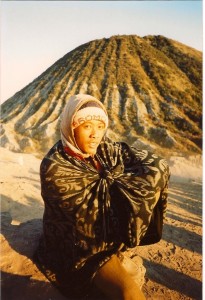 On the way to Bali I made one last Java stop at Gunung Bromo, Indonesia’s most spectacular active volcano, within hopping distance of the Java Sea. Intrepid travelers, their heads humming with caffeine, trek three kilometers across the moonlit moonscape, following a firefly trail of flashlights to the volcano. At the summit the crowd witnesses the spectacle of the fat yellow sun peeking over the rim of an alien planet, before its puckered crater lips take a prurient sip of Bromo-seltzer brew. Mountain Bromo High.
On the way to Bali I made one last Java stop at Gunung Bromo, Indonesia’s most spectacular active volcano, within hopping distance of the Java Sea. Intrepid travelers, their heads humming with caffeine, trek three kilometers across the moonlit moonscape, following a firefly trail of flashlights to the volcano. At the summit the crowd witnesses the spectacle of the fat yellow sun peeking over the rim of an alien planet, before its puckered crater lips take a prurient sip of Bromo-seltzer brew. Mountain Bromo High.
Goodbye Java. Bali Hai. Many Indonesians take their vacations in Bali just to ogle all the sun-worshipping tourists. Still Bali doesn’t evoke the Isle of the Gods so much as the Isle of of Australian Surfies at Kuta Beach, the Mad Max Spring Break City From Hell. Get your T-shirts here at Kuta’s Hard Rock Café! Leaving this Ozzie Outback of hawkers and tourists, hookers and addicts, all partying at the all-night discos, pick-up joints, and thunder domes, I finally ventured into the lush interior of paradise lost with its terraced rice paddies, palm trees, and smoking volcanoes. Like the Balinese, I wanted to look towards the mountains and away from the sea, which is believed, for obvious reasons, to be the source of evil spirits—most of them on package tours. At first, though, it was quite unnerving to be traveling towards these magic mountains on a luxury bus crammed with German-speaking tourists, passing temples and walls emblazoned with swastikas, until I remembered that these ancient mystic Hindu symbols were stolen by the Nazis, perverted for their own deadly uses.
Arriving in low-key Lovina, famous for its two-dollar full-body massages on black sand beaches, I settled down at the Café Malibu for espressos and brownies and waited to see if there would be any odd effects while listening to a homegrown band blasting Nirvana covers. The days of magic mushroom omelettes and psychedelic sunsets are over in Bali, now that it’s Indonesia’s number-one tourist attraction. The brownie was just a brownie. I decided to instead follow the Lombok Lizard Man—a grinning two-headed totem pole that bears an uncanny resemblance to a schizo Bart Simpson doll.
On the slowboat to Lombok, leaving from the idyllic white sand harbor of Padangbai, Bali, I met a victim of the government’s enforced transmigrasi program, wherein overcrowded Java is relieved by pressuring citizens to flee to farflung outer islands. This unwilling expatriate of the world’s largest mass migration wanted to practice his English:
“I Muslim,” he said, pointing to his fez-like black felt kopieh, “but Lombok has many Hindu, Catholic, too, and also Wektu Telu.”
What what? I thought.
“Wektu Telu. They say they Muslim, but they infidel. Dangerous you go their villages with no guide. I make good guide, very cheaps. They eat all that comes from Allah. They eat porks. They eat EVERYTHING.”
This made me reluctant to drop in on a remote village tea party as an uninvited dinner guest. Instead I shipwrecked myself on Lombok’s Gilli Islands with an arak hangover and the sky displayed like a kaleidoscope of cheap batik sarongs for sale on the beach. The three coral-fringed paradises of Gilli Air, Gilli Meno, and Gilli Trawangan offered Lord Jim wannabees much more than great snorkeling, white sandy beaches, and picturesque rides in horse-drawn dokars. A long-time budget backpackers hangout, this was supposedly the place to do shrooms. Without any hallucinogenic prompts, though, anybody can see, like, these strange blue lights (phosphorescent plankton) that mimic overhead stars washing ashore under moonshadow anyway. Nothing to do here but sing along with local long-haired guitar-strumming Gilligans gazing into the eyes of solo women travelers, singing old Cat Stevens songs. Occasionally the rumble of Lombok’s lava-spewing Gunung Rinjani breaks the silence like an overboiling pot in an Olympian diner.
The closest thing to a good cup of gilli is to be had at the isolated Good Heart Café (Gilli Meno), ideal for watching bleeding ulcerated sunsets and slipping into a dream—until friendly insect-eating geckos sound the alarm in the rafters. All water is pumped in by boat, so every cup of joe tastes vaguely of Drano; caffeine buzzers will quickly crash here. Better to cruise back south to Lombok proper with the retro migration of unladen European swallows and smiley-faced flower punks to a place called Kuta (nothing like Kuta, Bali), which features Indonesia’s most incredible beach (Tanjung Aan) and an attractive-looking café called The Cockatoo. Here I traded in my mild Gilli Belly for the much more severe Lombok Landslide. After that it was high time to get my insides straightened out and hop back like a hot-footed fakir to Bali for that much needed coffee break.
In Ubud, the cultural center and food capital of Bali, I went to see a cremation. Following the colorful and noisy procession down the street, the corpse held up in an elaborate wooden bier, we soon arrived at the ceremonial site. A crush of rubbernecking tourists strutted around like fighting cocks with autofocus eyes. Balinese mourners laughed and joked and cheered, and posed for videocams. As with any other spectator sport, enterprising locals sold peanuts and cold drinks as the stiff was laid out on the funeral pyre and torched up, bursting into flames. The Balinese believe the deceased move on to a new and improved reincarnated future, depending on their behavior in this life. In Hindu Bali, death is a party.
I desperately needed a coffee to drive away the bitter aftertaste of ghosts, and at the Café Lotus near the Monkey Forest Sanctuary (chock full o’ monkeys), I finally achieved coffee nirvana: the ultimate cup of java. Inside I heard more American accents than were to be found perhaps in all Indonesia. It was almost like a Manhattan coffeehouse, but with a view of an idyllic lotus pond and a Balinese temple. I ordered a cappuccino, and my stomach—not used to such potent brew—threatened to erupt like Ugung Batung, the holiest active volcano in Bali (fittingly dubbed the Navel of the World). I’d achieved the ultimate high in the former coffee capital of the universe. In what Indonesians sometimes call the Land Under the Rainbow, I shot up like a rocket through the caffeine roof of the world, my tongue frothing with exploding stars, and I tried to set the night on fire.

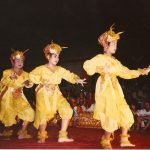
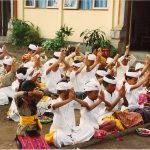
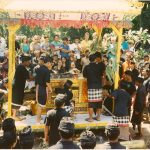

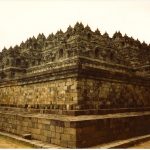
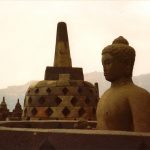
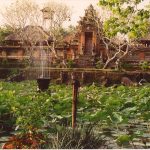
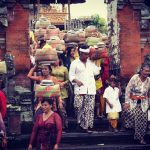

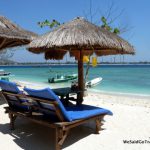
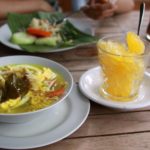
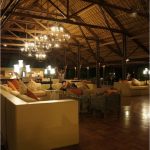

Leave a Reply